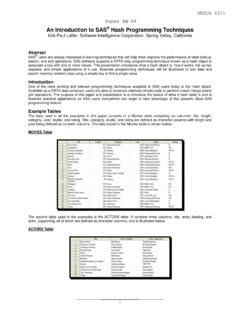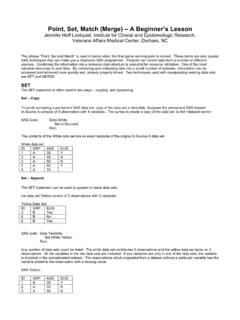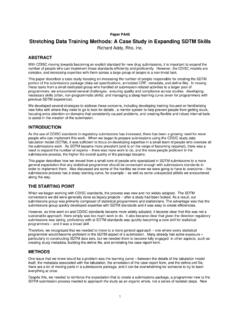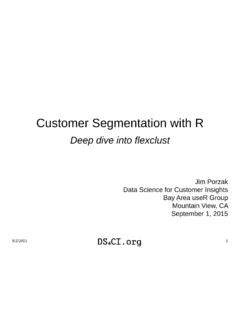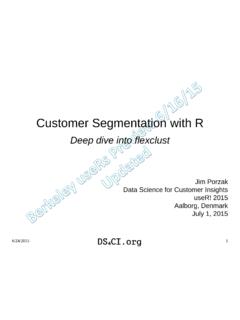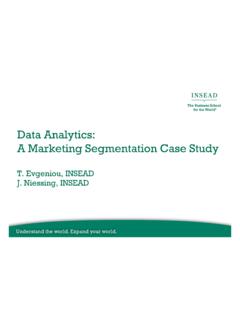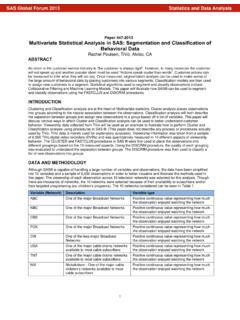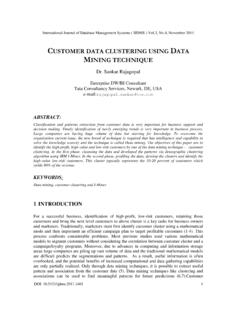Transcription of Developing a Marketing Geographic Segmentation …
1 Developing a Marketing Geographic Segmentation System Using SAS SoftwareKellie M. Poulin and Allison N. FreemanMarsh Affinity Group Services, Ft. Washington, PAABSTRACTT oday's marketers are challenged by decreasing response ratesand increasing competition. In order to continue to thrive in theindustry, the successful marketer must move away fromtraditional mass Marketing and toward a one-to-one customer -based approach (Peppers and Rogers, 1997). In order to makethis change, marketers must be able to find and effectively uselow-cost information to improve their level of customer popular approach is to implement an intelligent marketingsegmentation system.
2 This paper presents a low-cost, efficientsolution integrating publicly available data and the marketer's owncustomer database to create a Segmentation system that will aidin identifying, locating, and reaching customers effectively. Theexample presented in this paper will highlight the process ofcreating a ZIP code Segmentation system with Base SAS ,SAS/STAT and the SAS Bridge for ESRI. The process forcreating a Segmentation system can be implemented across alloperating systems, while the display of the system using ESRIcan be implemented in a Windows environment.
3 The topicsdiscussed in this paper are appropriate for the intermediateprogrammer or statistical Marketing industry has changed dramatically over the pastdecade. The advent of inexpensive information technology hasmade it possible for companies to move from mass Marketing , ormarketing the same product to all consumers in the same way, toone-to-one Marketing . In one-to-one Marketing , informationabout the customer is used to tailor products, services, andcommunications to each individual (Peppers and Rogers 1997).
4 The new challenge for the marketer is finding affordableinformation that can be used effectively to differentiate theircustomers. This paper will discuss one very low-cost methodthat can be used as a first step in this has been shown that people with similar demographiccharacteristics and product usage patterns tend to live near oneanother. In other words, there are Geographic areas whereresidents are more likely to respond to certain product offers dueto their environment and demographics. Several companieshave created groupings of similar areas, called geographicsegmentation systems.
5 These can be purchased and applied toany customer database based on where the customer lives(Shepard 1995). The Conclusion of this paper lists severalvendors of Geographic level Segmentation systems and providestheir web site addresses. While these systems are often helpfulin identifying customers with similar buying patterns, they areoften costly and are not designed for an individual company'sspecific product offerings. Custom designed clusters can bemore powerful because information about a company's currentcustomer base can be incorporated into the model.
6 In ourexperience, we have found that the data we collect about ourcustomers, such as past customer behavior and productspurchased, are valuable in Developing custom-built segmentationtools and response models, thereby making them much morepredictive than purchased Geographic Segmentation systems can be developed forlittle cost using data from the Census Bureau, othergovernment sources, and customer information aggregated to ageographic level. Census data are available on state, county,census tract, census block group, and ZIP code levels.
7 Thus,clusters could be developed on any of these these clusters are developed, how can they aid marketersand business analysts? Marketers and analysts can usegeographic Segmentation tools to track buying trends and othercustomer behavior. A customer who falls into a specific segmentwill often respond to product offers in the same way that otherpeople in that segment will respond. Also, Segmentation systemscan help to determine where a current customer base isconcentrated and where to focus new Marketing efforts.
8 Analystscan locate areas with low customer penetration that have similargeographic characteristics to areas with high customerpenetration and can use this information in their marketingstrategies. A Geographic Segmentation system also enablesanalysts to use environmental, demographic and behavioralinformation to create appropriate Marketing Developing a custom Segmentation system, you should beginby asking the following questions: What are the basic characteristics of my best customers?What is their level of income?
9 What is their average ageand education level? Where do my best customers live?Do they live in areas with high population densities? Dothey live where a large portion of the population is retired? What Geographic factors affect the use of my product?Are my prices more competitive in some areas of thecountry? Is my product used more in warmer climates thanin colder climates?Often these answers are found through statistical analysis and inbrainstorming sessions with the Marketing staff of your answers to these and other related questions will lead you todecide which data elements you will want to consider whencreating your custom Segmentation the example discussed in this paper, we illustrate the stepsinvolved in Developing a ZIP code Segmentation system usingcustomer data from our Marketing database along withgeographic-level data from the Census.
10 Although it is notcovered in this paper, a Geographic -level Segmentation systemcan often be a building block to more sophisticated segments can be used as inputs into individual-levelsegmentation systems and other models that include individualand household-level customer PERTINENT DATAA Segmentation system, or clustering schema, is designed toassign people to groups based on related characteristics. Thevariables you choose should be data elements that describe yourcustomer base rather than the variables that are "statisticallysignificant contributors," as would be used in Developing apredictive model (Shepard 1995).


